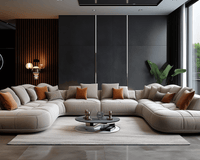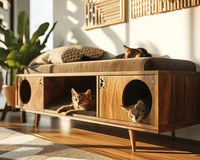Building a cat litter box enclosure is a rewarding project that can elevate your cat's comfort and add a unique touch to your home. Here's a detailed walkthrough to help you construct a functional and appealing enclosure.

1. Planning Your Enclosure
- Understanding Your Cat's Needs:
Understanding your cat's needs is essential. Assess the required space, considering comfort and movement. Observe whether your cat prefers privacy, seeking enclosed spaces, or openness, favoring accessibility and a wider view. Tailoring the enclosure to these preferences ensures a comfortable and welcoming space for your feline friend.
- Design and Material Selection:
When selecting materials for the enclosure, prioritize durability and aesthetics. Wood or PVC offer sturdiness and ease of crafting. Ensure the chosen materials align with your desired aesthetic appeal while being pet-safe and easy to maintain. Consider factors like resistance to moisture and odor control for a durable and visually pleasing cat litter box enclosure.
- Space Assessment:
Assess the space needed considering your cat's comfort and mobility. Ensure ample room for movement and relaxation, avoiding cramped quarters. A well-sized enclosure provides freedom for your cat to move comfortably while maintaining a cozy and secure environment.
- Privacy vs. Openness:
Observing your cat's behavior is key to understanding their enclosure preferences. Some cats seek enclosed spaces for a sense of security and privacy, while others enjoy open areas for a broader view. Notice whether your cat tends to retreat to secluded spots or prefers to survey their surroundings openly. Tailoring the enclosure to match these observed behaviors ensures a space that aligns with your cat's comfort and habits.

2. Step-by-Step Construction
· Gathering Materials and Tools:
When gathering materials and tools for the project, prioritize pet-safe elements. Select sturdy yet pet-friendly materials such as untreated wood, ensuring durability without compromising your cat's safety. Additionally, acquire essential tools like a saw, drill, and screws suitable for woodworking. Choosing appropriate tools ensures precision and ease during construction. Prioritize pet-safe paints or finishes, if desired, to maintain a healthy environment for your cat. This thoughtful selection of materials and tools contributes to a secure and comfortable enclosure for your feline companion.
· Durability and Wear Resistance:
Ensuring durability and wear resistance in a litter box is crucial. Opt for materials like high-quality plastic or reinforced materials designed to withstand frequent use and scratching. Look for sturdy construction that can endure your cat's activities without easily showing wear and tear. Additionally, consider smooth surfaces that are easy to clean, maintaining hygiene and preventing odor buildup over time. Prioritizing durability not only prolongs the litter box's lifespan but also provides a comfortable and hygienic space for your cat's daily routines.
· Building the Structure:
Constructing the enclosure involves precise cutting and assembly according to the design blueprint. This phase ensures proper ventilation, crucial for your cat's comfort. Secure construction with robust fastening and sturdy materials ensures durability. Prioritize safety by avoiding sharp edges or protruding elements within the enclosure, creating a secure haven for your cat.

3. Customizing the Enclosure
· Accessibility and Comfort:
Enhancing accessibility and comfort in the enclosure is vital. Install an easy-entry doorway, ensuring convenience for your cat to enter and exit comfortably. Additionally, incorporate cozy bedding or mats inside the enclosure, providing a warm and inviting space for rest and relaxation. These elements contribute to creating a secure and comfortable environment, promoting your cat's well-being and encouraging prolonged and contented use of the litter box enclosure.
· Ventilation and Airflow:
Ventilation and airflow are vital for a cat's litter box enclosure. Ensuring proper airflow within the space prevents the accumulation of unpleasant odors, promoting a fresh environment essential for your cat's comfort. Enhance airflow by strategically installing small vents or perforations, aiding in odor control and maintaining a pleasant atmosphere within the enclosure. These measures contribute to a hygienic and comfortable space for your cat's toileting needs.
· Odor Control and Cleaning:
For effective odor control and maintenance, prioritize incorporating features that minimize smells, like covered designs or carbon filters. Opt for surfaces and liners that are easy to clean and sanitize, ensuring routine maintenance is hassle-free. Regularly scoop waste, change litter, and wipe surfaces with pet-safe cleaning agents. These steps not only reduce odors but also maintain a hygienic environment, promoting your cat's comfort and encouraging consistent litter box usage.
· Noise Reduction and Tranquility:
Implementing noise reduction strategies enhances your cat's litter box experience. Choosing materials or designs that minimize noise during use creates a tranquil environment, alleviating stress for sensitive cats. Additionally, incorporating soft materials or padding diminishes noise from digging or scratching, ensuring a serene atmosphere that promotes your cat's overall comfort and relaxation within the enclosure. These measures contribute to a quieter and more peaceful environment for your feline friend's toileting routine.

4. Making It Cat-Friendly
- Introducing Your Cat:
Introducing your cat to the enclosure should be a patient process. Start by leaving the enclosure open and accessible, allowing your cat to approach it voluntarily. Incorporate familiar scents or toys inside to encourage exploration. Avoid rushing the introduction; let your cat investigate the new space at its own pace. Offer positive reinforcement, such as treats or gentle praise, each time your cat shows interest or enters the enclosure. This gradual approach helps build familiarity and comfort, ensuring your cat associates the enclosure with safety and comfort rather than stress
- .Maintenance Tips:
Maintaining a regular cleaning schedule for the enclosure is crucial for your cat's hygiene. Implement a routine to remove waste, replace litter, and sanitize surfaces. Additionally, be proactive in identifying and addressing common issues like odors, wear and tear, or necessary modifications. Regular checks for repairs or adjustments ensure a clean, functional, and comfortable environment for your cat's well-being.

Conclusion
Crafting a DIY cat litter box enclosure isn't just about meeting your cat's needs; it's an opportunity to infuse your home with personalized creativity. This comprehensive guide empowers you with step-by-step instructions, ensuring the creation of a space that's not only comfortable and practical but also visually appealing. By following these instructions, you'll build a customized haven for your feline companion—one that harmonizes functionality with aesthetics, adding both value and charm to your living space while prioritizing your cat's comfort and well-being.

FAQs about DIY cat litter box enclosures
1. What materials are suitable for constructing a cat litter box enclosure?
Selecting pet-safe materials is crucial. Choose durable options like untreated wood or PVC, ensuring safety for your cat while providing ease of construction and long-term reliability for the enclosure.
2. How can I determine the right size for the enclosure?
When planning the enclosure, factor in your cat's size and agility. A generous space permits ease of movement and comfort, yet it's vital not to go excessively large, as it might compromise the cozy atmosphere that cats often prefer in their private spaces. Balancing ample room with a snug feel is key to ensuring your cat's contentment within the enclosure.
3. How do I introduce my cat to the new enclosure?
To acclimate your cat, start by leaving the enclosure open. Place treats or familiar scents inside, enticing exploration at your cat's comfortable pace. This gradual introduction encourages familiarity and eases their transition into the new space.
4. What's the best way to maintain and clean the enclosure?
Establish a regular cleaning routine using pet-safe cleaning agents. Choose materials that are easy to wipe or wash, reducing odor and maintaining hygiene.
5. Can I personalize the enclosure's design to match my home's aesthetics?
Absolutely! Consider adding decorative elements, such as paint or trim, to match your home decor. Just ensure any added elements are safe for your cat.

-------------------------------------------------------------
Your encouragement and support are the driving force of our creation. If you want to support us, you can pay a small amount of Bitcoin or Ethereum to the following address:
Bitcoin:
bc1q56xsdwhnva969w38808yu3erxjrxqludn9ehg9

Ethereum:
0x555C43d02140634250e965F963733Fb32F974D67











